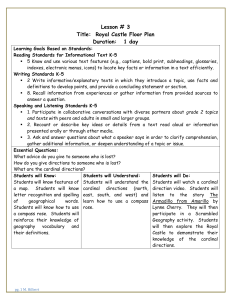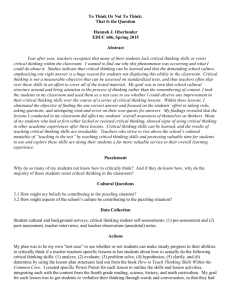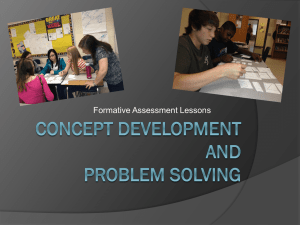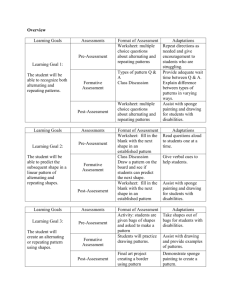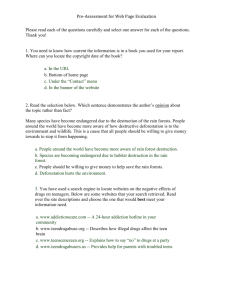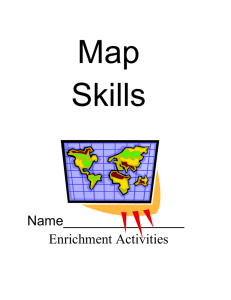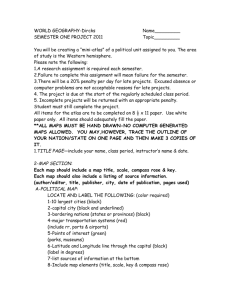ED418 PrePostAssessmentNarrativeInstrumentKey
advertisement
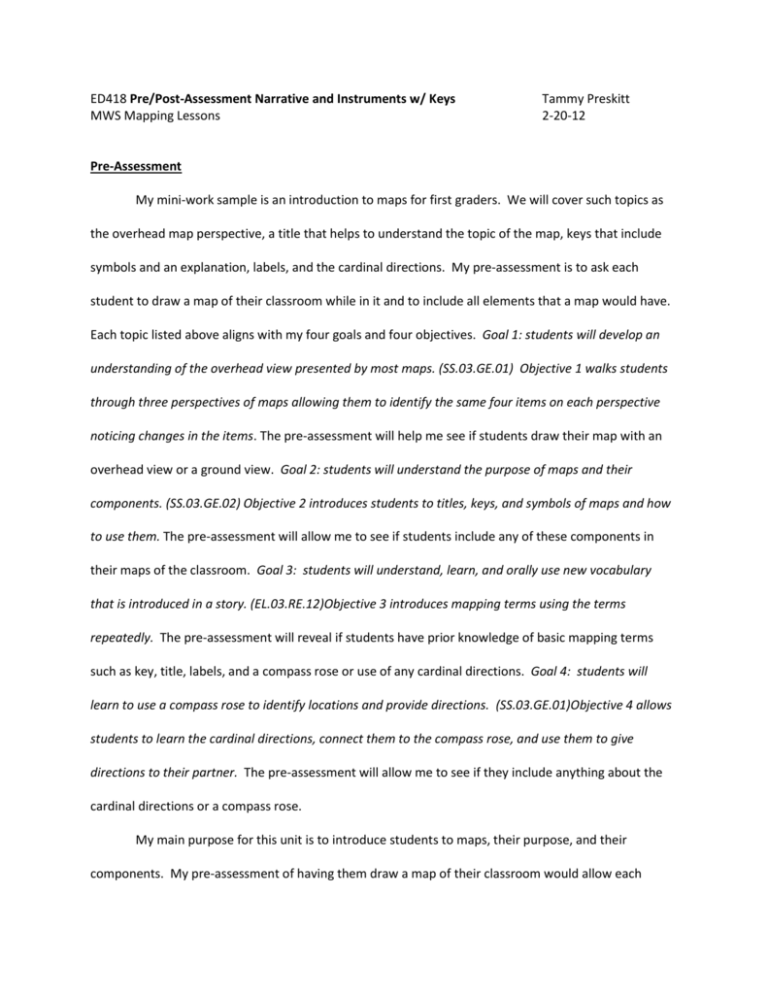
ED418 Pre/Post-Assessment Narrative and Instruments w/ Keys MWS Mapping Lessons Tammy Preskitt 2-20-12 Pre-Assessment My mini-work sample is an introduction to maps for first graders. We will cover such topics as the overhead map perspective, a title that helps to understand the topic of the map, keys that include symbols and an explanation, labels, and the cardinal directions. My pre-assessment is to ask each student to draw a map of their classroom while in it and to include all elements that a map would have. Each topic listed above aligns with my four goals and four objectives. Goal 1: students will develop an understanding of the overhead view presented by most maps. (SS.03.GE.01) Objective 1 walks students through three perspectives of maps allowing them to identify the same four items on each perspective noticing changes in the items. The pre-assessment will help me see if students draw their map with an overhead view or a ground view. Goal 2: students will understand the purpose of maps and their components. (SS.03.GE.02) Objective 2 introduces students to titles, keys, and symbols of maps and how to use them. The pre-assessment will allow me to see if students include any of these components in their maps of the classroom. Goal 3: students will understand, learn, and orally use new vocabulary that is introduced in a story. (EL.03.RE.12)Objective 3 introduces mapping terms using the terms repeatedly. The pre-assessment will reveal if students have prior knowledge of basic mapping terms such as key, title, labels, and a compass rose or use of any cardinal directions. Goal 4: students will learn to use a compass rose to identify locations and provide directions. (SS.03.GE.01)Objective 4 allows students to learn the cardinal directions, connect them to the compass rose, and use them to give directions to their partner. The pre-assessment will allow me to see if they include anything about the cardinal directions or a compass rose. My main purpose for this unit is to introduce students to maps, their purpose, and their components. My pre-assessment of having them draw a map of their classroom would allow each student to include what they knew about maps. In viewing each of their maps, I could use a check list consisting of title, key, symbols, explanation, labels, perspective, and classroom items. Each component is worth one point, with total amount equaling seven points. I did not weigh one component as more important than another because I did not expect first graders to know all these components of maps. I administered the pre-assessment the week before giving the three lessons. I chose to give them this pre-assessment after their lunch and recess because it is when I would be teaching the miniwork sample. The food and activity would reenergize them and have them awake, alert, and ready to learn. When all were seated at their tables (4 to each table), I handed a blank page to each student and asked them to draw a map of their classroom including all that they knew about maps. They could use pencils, pens, crayons, or markers. I gave no further instructions because I wanted them to recall and use any prior knowledge they already possessed. Students were then given twenty minutes to complete their maps. I gathered up their maps, thanked them letting them know that in the following week we would be learning about maps. My post-assessment will be the maps they draw of their bedroom. The only change from the pre-assessment will be their bedroom instead of the classroom. I chose their bedroom because this would allow them to use their memory instead of relying on their sight. This would also have each student making a map of their own room and not copying from a table partner. Post-Assessment The post-assessment will parallel the pre-assessment by having students draw a map of their bedroom. This is different from the pre-assessment where they drew a map of their classroom. I chose their bedroom because this would allow them to use their memory instead of relying on their sight. The second difference from the pre-assessment is that I will tap into their newly acquired knowledge by revisiting the stories we’ve read and noticing what good maps include: title, key including symbols with explanation, labels, compass rose, and an overhead perspective before asking them to draw a map of their bedroom. I will again have a list of each of these items with each being worth one point equaling seven points total. The post-assessment aligns with my goals and objectives in the same ways as for the preassessment. Goal 1: students will develop an understanding of the overhead view presented by most maps. (SS.03.GE.01) Objective 1 walks students through three perspectives of maps allowing them to identify the same four items on each perspective noticing changes in the items. The post-assessment will help me see if students draw their map with an overhead view or a ground view. Goal 2: students will understand the purpose of maps and their components. (SS.03.GE.02) Objective 2 introduces students to titles, keys, and symbols of maps and how to use them. The post-assessment will allow me to see if students include any of these components in their maps of the classroom. Goal 3: students will understand, learn, and orally use new vocabulary that is introduced in a story. (EL.03.RE.12) Objective 3 introduces mapping terms using the terms repeatedly. The post-assessment will reveal if students used their newly acquired knowledge of basic mapping terms such as key, title, labels, and a compass rose or use of any cardinal directions. Goal 4: students will learn to use a compass rose to identify locations and provide direction. (SS.03.GE.01) Objective 4 allows students to learn the cardinal directions, connect them to the compass rose, and use them to give directions to their partner. The post-assessment will allow me to see if they include anything about the cardinal directions or a compass rose. I will administer the post-assessment after lunch and recess. The first part of the postassessment will be the maps they make of their bedroom at the end of lesson two. The second part of the post-assessment will be giving them back their maps at the end of lesson three and asking them to draw a compass rose on their map identifying each of the cardinal directions. I did this in two parts because we could not cover everything in one lesson. Also because cardinal directions are a huge concept for first graders and what I really want them to grasp is the four cardinal directions and how that connects to a map. In my pre-assessment I had the students draw the same place (classroom) for their maps and discovered that because they were sitting four to a table, it was easy for them to see what the other was doing and copying parts of their neighbors’ map. So, for the post-assessment, I asked them to draw a map of their bedrooms, counting on the fact that elbow neighbors would not know what their partners’ bedroom looked like. This should help produce authentic maps of each bedroom. Pre-Assessment Instrument and Answer Key Yes No Item Points ____ ____ Overhead Perspective _______ ____ ____ Title _______ ____ ____ Key _______ ____ ____ Symbols _______ ____ ____ Explanations _______ ____ ____ Labels _______ ____ ____ Compass Rose with cardinal directions _______ Total Excellent: 6-7 points Competent: 3-5 points Emerging: 1-2 points _______ Post-Assessment Instrument and Answer Key: Yes No Item Points ____ ____ Overhead Perspective _______ ____ ____ Title _______ ____ ____ Key _______ ____ ____ Symbols _______ ____ ____ Explanations _______ ____ ____ Labels _______ ____ ____ Compass Rose with cardinal directions _______ Total Excellent: 6-7 points Competent: 3-5 points Emerging: 1-2 points _______
